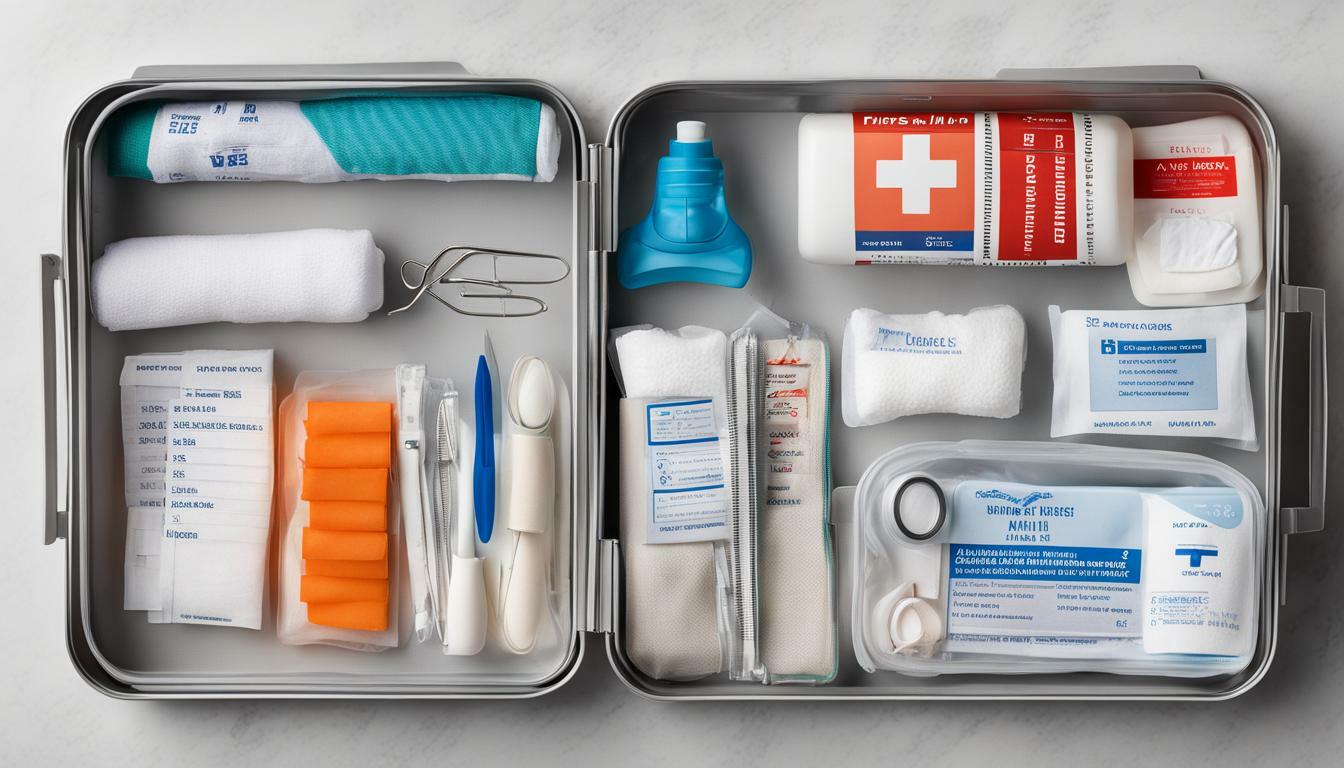Having a well-equipped first aid kit is crucial for any emergency situation, whether at home or on-the-go. However, just having a first aid kit is not enough. It’s equally important to ensure that your kit is well-maintained and regularly restocked.
In this section, we’ll provide you with a comprehensive checklist to help you master the art of maintaining and restocking your first aid kit. By following this guide, you’ll be well-prepared for any emergency in UK homes or on-the-go. Let’s get started!
Key Takeaways
- Maintaining and restocking your first aid kit is essential for preparedness during emergencies.
- Regular maintenance of your first aid kit is crucial to ensure that all essential supplies are ready for use when needed.
- Check your first aid kit regularly for missing or expired items and replace them as needed.
- Proper storage and organization of your first aid kit can make a significant difference during emergencies.
- First aid training and certification are important to ensure you have the necessary skills and knowledge to use your first aid kit effectively.
Importance of Regular Maintenance
Maintaining your first aid kit is crucial for ensuring that it is always ready to use when needed. Regular maintenance of your first aid kit also helps to keep track of expiring items, replace missing items and restock supplies as needed.
Regular maintenance of your first aid kit also guarantees that all essential items are available and up-to-date. This is important to keep the kit effective and reliable in case of an emergency.
By maintaining your first aid kit regularly, you will ensure that it remains a reliable resource for helping yourself or others in any emergency situation.
As such, it is important to incorporate a routine system to maintain and restock your first aid kit to ensure that all items remain functional and up-to-date.
Importance of Maintenance for First Aid Kit Essentials
Maintaining your first aid kit essentials is paramount for staying prepared in any emergency situation. Even if your first aid kit is rarely used, it is essential to ensure that it remains up-to-date and well-stocked at all times.
Essential items, such as plasters, bandages, and medication, need to be regularly maintained to ensure they are in proper working order when required. By keeping track of the expiration dates of the items, you can easily replace expired supplies that might be ineffective, which can be vital in emergency situations.
Regular maintenance of your first aid kit also helps keep items organized and easily accessible, making it simple to respond to emergencies effectively.
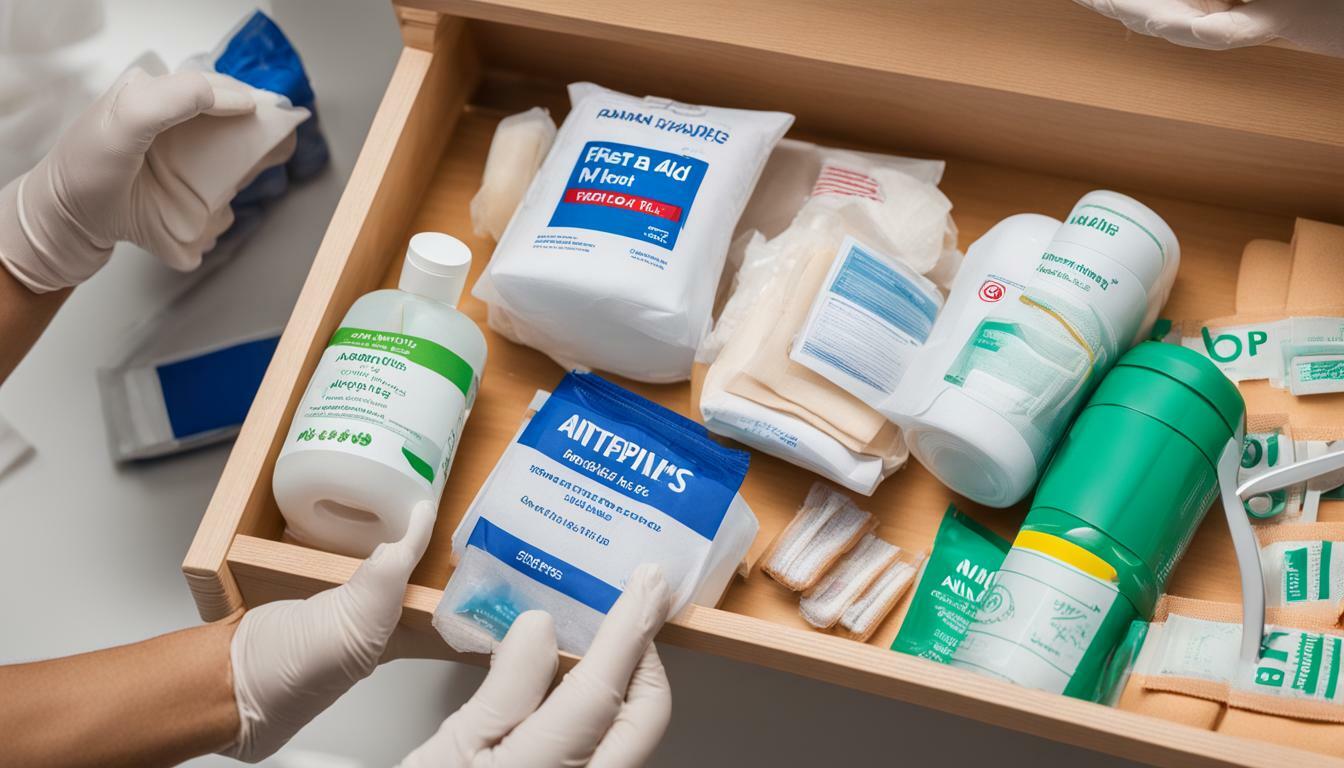
Image alt attribute: Maintaining first aid kit
Assessing and Replacing Expired Items
Regularly assessing your first aid kit is vital to ensure you have all the necessary first aid supplies to treat injuries. It is equally important to check for expired items in your kit, as expired items can lose their effectiveness and have unintended consequences when used. In this section, we’ll guide you on how to perform an inventory check and replace any expired items in your first aid kit inventory.
| Step | Action |
|---|---|
| 1 | Check the expiration dates of all items in your first aid kit. |
| 2 | Discard any items that have expired or are damaged. |
| 3 | Make a list of the items that need to be replaced. |
| 4 | Restock your first aid kit with new, unexpired items. |
It is recommended to perform an inventory check and replace expired items every six months, or more frequently if you use your first aid items regularly or store it in extreme temperatures. By maintaining a well-stocked and up-to-date first aid kit, you can ensure that you are prepared for any emergency.
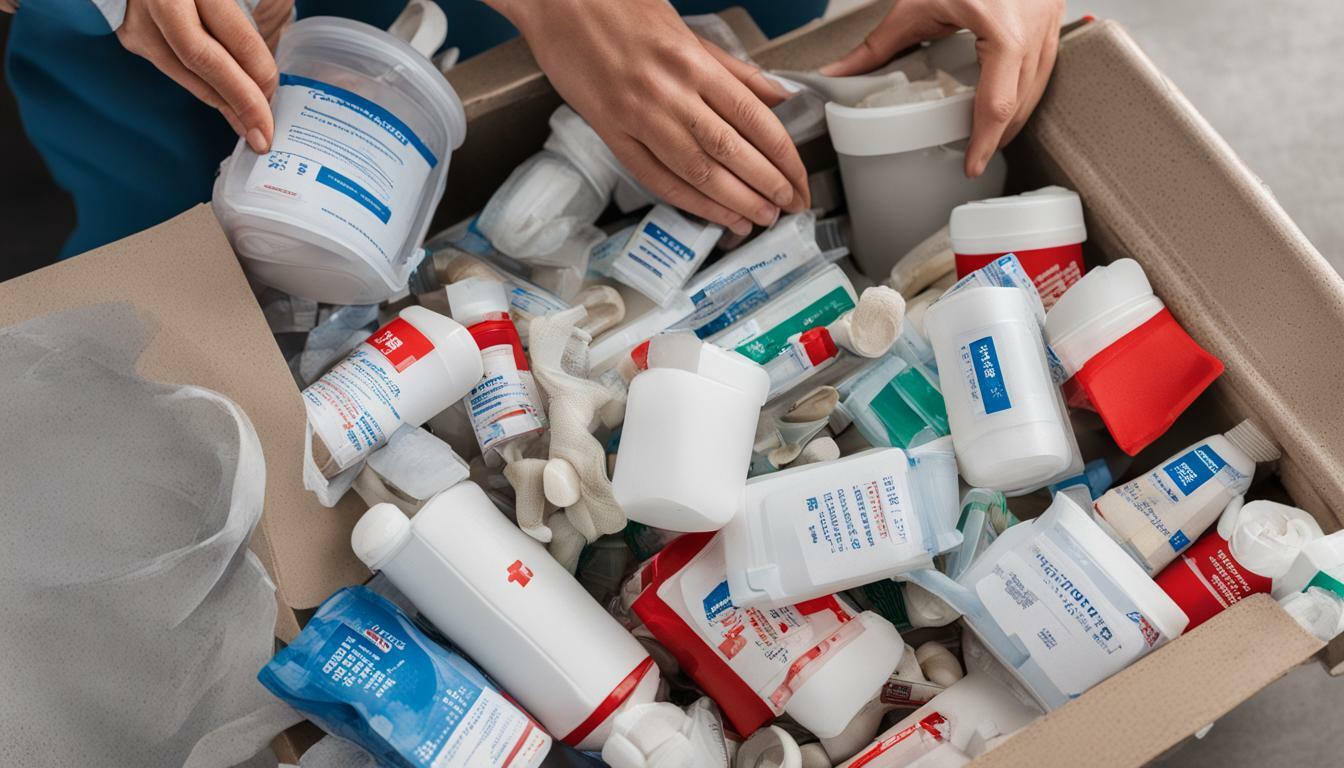
Restocking Basic First Aid Supplies
Restocking your first aid kit regularly ensures that you have all the necessary supplies to handle emergencies effectively. Here is a checklist of essential first aid items that you should include in your kit:
| Item | Quantity |
|---|---|
| Adhesive bandages (various sizes) | At least 10 |
| Gauze pads (sterile, various sizes) | At least 4 |
| Elastic bandages | At least 2 |
| Adhesive tape | 1 roll |
| Tweezers | 1 pair |
| Scissors | 1 pair |
| Antiseptic wipes | At least 4 |
| Antibiotic ointment packets | At least 2 |
| Pain relievers (e.g. aspirin, ibuprofen) | At least 4 tablets |
| Antihistamine tablets | At least 4 tablets |
Remember to check your first aid kit regularly and replace any used or expired items. It’s also important to keep an eye on the quantities of each item to ensure that you have enough for future emergencies.
When restocking your first aid kit, consider any specific needs of your household, such as medications or treatments for allergies or other conditions.
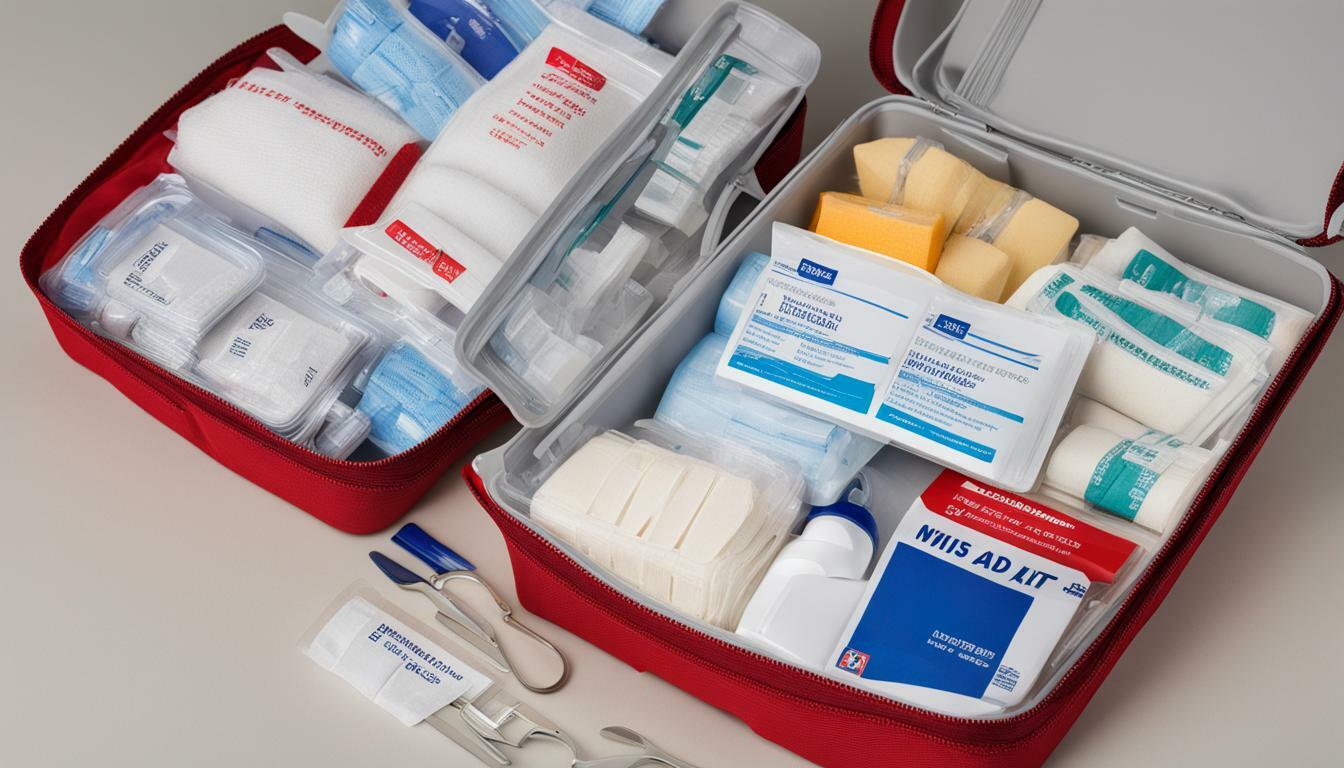
Special Considerations for First Aid Kits at Home
While many of the essential first aid kit items remain the same for both at-home and on-the-go kits, there are a few additional considerations to keep in mind when maintaining a first aid kit in a household setting. By preparing for common scenarios and properly stocking up on the items you’ll need, you can ensure that your first aid kit remains fully equipped to handle any emergency.
Child-Specific Items
If you have young children in your household, it’s important to include child-specific items in your first aid kit. This may include infant and children’s pain relievers, children’s adhesive bandages, and any necessary medication or medical supplies specific to their needs. In addition, it’s important to store these items in a child-safe location, such as a locked cabinet or out of reach.
Emergency Contact Information
In case of an emergency, it’s important to have easy access to emergency contact information. Include a list of important phone numbers for medical professionals, including doctors, hospitals, and emergency services. You may also want to add information about any known allergies or medical conditions for family members.
Extra Supplies
When you’re at home, you have the luxury of storing extra supplies in case of an emergency. Make sure to include extra bandages, gauze, and cleaning solutions so that you can easily replace used items. You may also want to consider including items like a thermometer or ice packs, which can be particularly useful in at-home emergencies.
Stocking up on Essentials
Just like with on-the-go first aid kits, it’s important to regularly inspect and restock your at-home first aid kit. Check for missing or expired items, and make sure to keep a list of items you need to purchase. Some essential items to make sure you have stocked up include:
| First Aid Kit Essentials |
|---|
| Adhesive bandages of various sizes |
| Gauze pads and roll |
| Antiseptic wipes or solution |
| Tweezers and scissors |
| Latex gloves |
| Pain reliever (aspirin, ibuprofen, acetaminophen) |
| Emergency blanket |

By taking these special considerations into account and regularly maintaining your first aid kit, you’ll be well-prepared for any emergency that may arise in your home. Remember to always check expiration dates and keep your kit well-stocked, so you can have peace of mind knowing you have everything you need in case of an emergency.
Portable First Aid Kits for On-the-Go
Whether you’re going on a camping trip or a long drive, having a portable first aid kit is essential for quick response in emergencies. Your first aid kit should be compact and easy to carry, containing all the essential items necessary for first aid treatment.
When assembling a portable first aid kit, it’s important to consider the location and duration of your trip. For example, a camping trip may require additional supplies like insect repellent or burn ointment. A basic portable first aid kit usually includes:
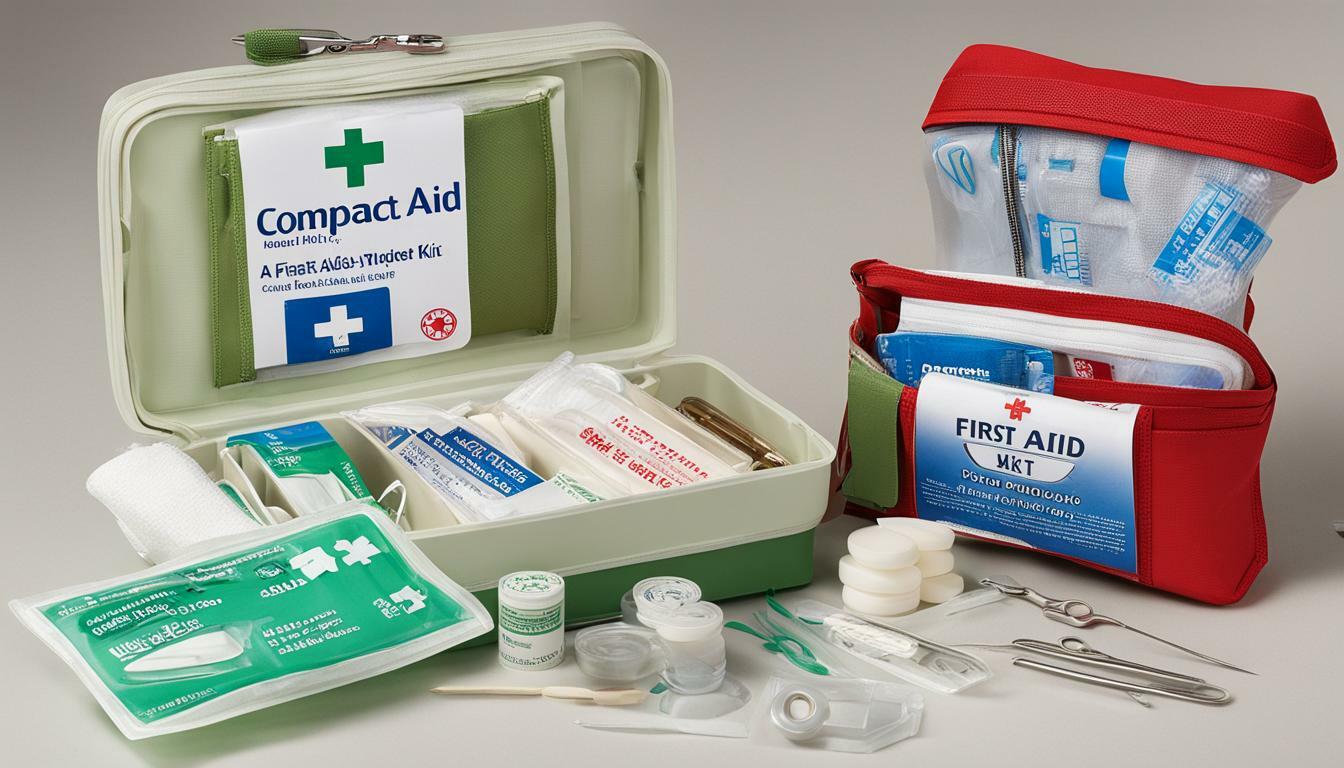
- Band-Aids of various sizes
- Gauze pads
- Adhesive tape
- Antiseptic wipes
- Tweezers
- Scissors
- Disposable gloves
- Instant cold pack
Make sure to store your portable first aid kit in a waterproof and durable container to prevent damage to the kit and its contents. It’s also important to check the expiration dates of your supplies and regularly maintain and restock your kit to ensure it’s ready for use.
Additional Considerations for On-the-Go First Aid Kits
Depending on the location and activities of your trip, you may want to consider adding the following items to your portable first aid kit:
| Activity/Location | Additional First Aid Kit Item |
|---|---|
| Outdoor Activities | Insect repellent |
| Beach or Pool | Sunscreen |
| Long hikes or walks | Blister pads |
| In a foreign country | Anti-diarrhea medication |
Remember, a portable first aid kit is only effective if it’s properly maintained and readily accessible in an emergency. Make sure to check your kit before each trip and restock any missing or expired items. With a well-maintained portable first aid kit, you can have peace of mind knowing you’re prepared for any on-the-go emergency.
Storing and Organising Your First Aid Kit
Keeping your first aid kit well-organised and easy to access can make all the difference in an emergency. Here are some tips to help you store and organise your first aid supplies effectively:
Choose a Suitable Storage Location
Firstly, choose a suitable location to store your first aid kit. This should be somewhere easily accessible and visible, such as a cupboard or shelf in the kitchen or bathroom. Avoid hiding your kit away in an obscure location where it may be difficult to locate in an emergency.
Organise Your Supplies
Organising your supplies into categories can help you find what you need quickly. For example, group together bandages, plasters, and antiseptic wipes in one section and medications like painkillers and antihistamines in another.
Consider using separate storage compartments or zip-lock bags to keep like items together and easy to access.
Create an Inventory List
Keep track of the supplies in your first aid kit by creating a detailed inventory list. This will help you keep track of what’s inside, identify any missing items, and plan for restocking.
Update your inventory list regularly and include key details such as expiration dates, quantity, and location within your storage area.
Regularly Check and Restock Your Kit
To ensure your first aid kit is always adequately stocked and up-to-date, it’s essential to regularly check and restock it. Use your inventory list to identify any missing or expired items and replace them promptly.
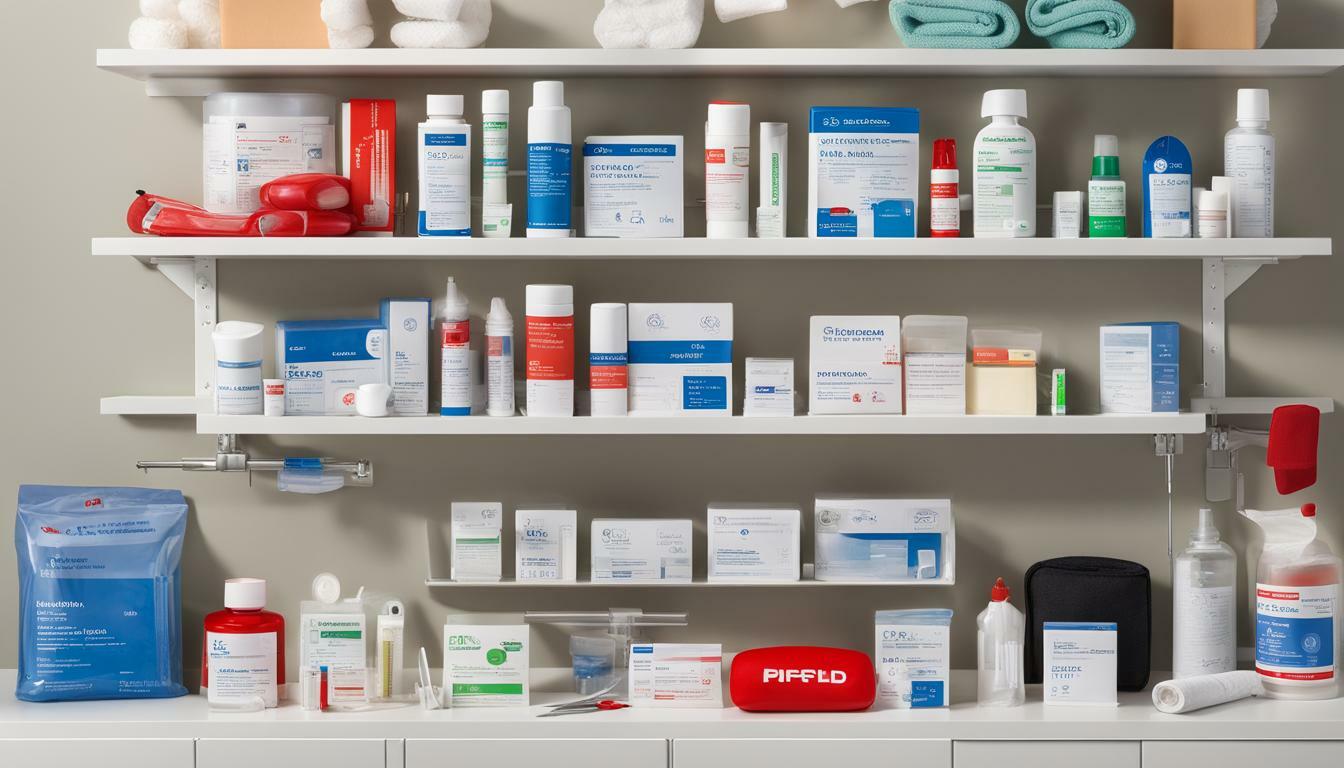
Consider adding extra supplies during seasonal changes or if you’re planning a trip. This will ensure you’re well-equipped for any emergency situation that may arise.
By following these tips for storing and organising your first aid kit, you’ll be well-prepared to handle any emergency situation that comes your way.
Checking for Missing Items
Regularly checking your first aid kit for missing items is essential to ensure its effectiveness. After all, you don’t want to discover that you’re missing vital supplies when an emergency strikes. To avoid this, we recommend performing a thorough inventory check at least once every three months.
Here’s a first aid kit checklist to help you keep track of what your kit should contain:
| Item | Quantity |
|---|---|
| Adhesive bandages (assorted sizes) | At least 20 |
| Gauze pads (assorted sizes) | At least 10 |
| Medical tape | 1 roll |
| Antiseptic wipes or spray | At least 10 |
| Tweezers | 1 pair |
| Scissors | 1 pair |
| Disposable gloves | At least 2 pairs |
| Instant cold pack | 1 pack |
| First aid manual | 1 copy |
If you find that any items are missing or running low, maintaining your first aid kit means taking the time to replace them promptly. It’s also a good idea to add any additional items that you believe might be useful for your specific needs or situations, such as medication or emergency contact information.
Remember, a missing item could mean the difference between a small injury and a serious emergency. By regularly checking and restocking your first aid kit, you can ensure that you’re always prepared for any situation.
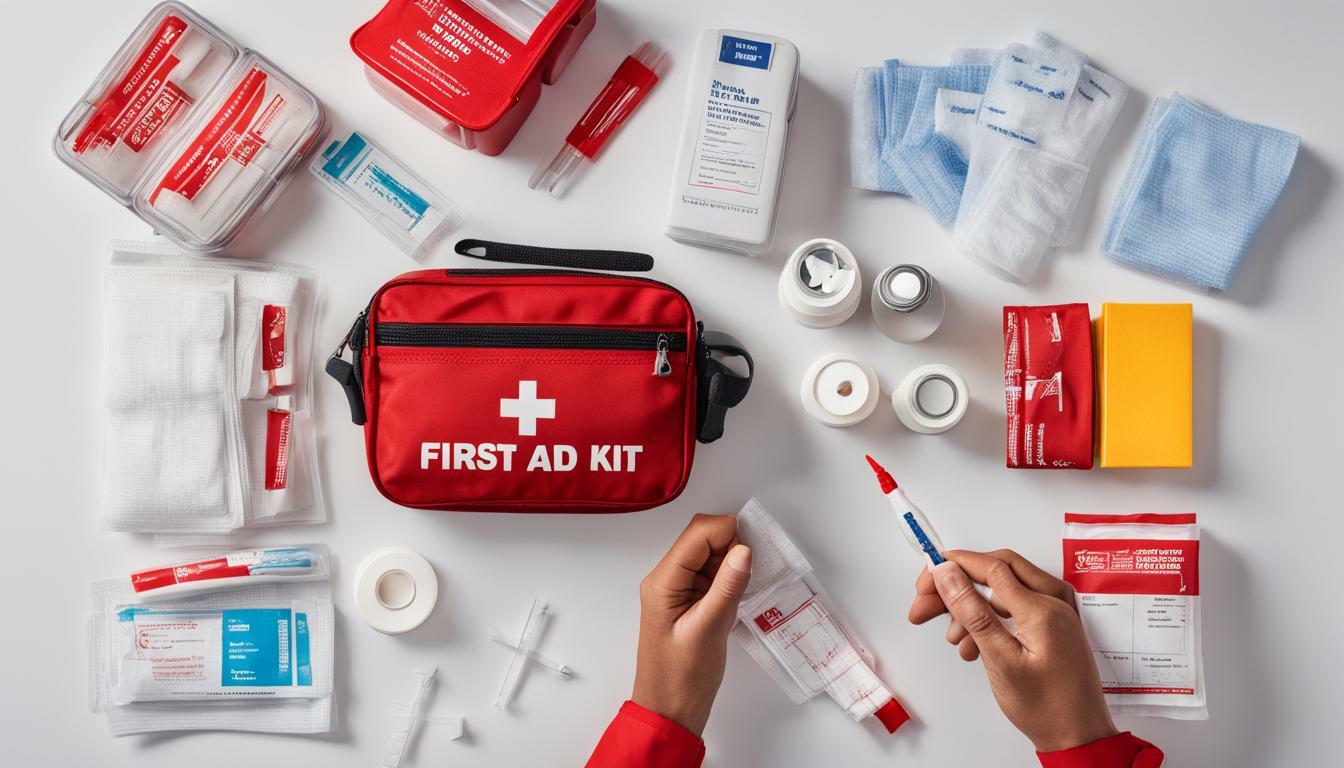
Maintaining First Aid Kit in Extreme Weather Conditions
Extreme weather conditions can have a significant impact on the shelf life and effectiveness of your first aid supplies. It is important to maintain your first aid kit in varying weather conditions to ensure it remains ready for emergencies.
Here are some tips to keep your first aid kit well-maintained:
- Store your first aid kit in a cool, dry place. Avoid exposing it to direct sunlight or moisture, as it can damage the supplies and decrease their effectiveness.
- Check expiration dates regularly. Extreme temperatures can accelerate the expiration process of certain supplies, such as medications. It’s essential to check expiration dates more frequently in extreme weather conditions.
- Add weather-specific items to your kit. Depending on the weather conditions in your area, you may need to include extra supplies such as hand warmers, insect repellent, or sunscreen.
By following these tips, you can maintain your first aid kit in extreme weather conditions and ensure that it is always ready for any emergency.
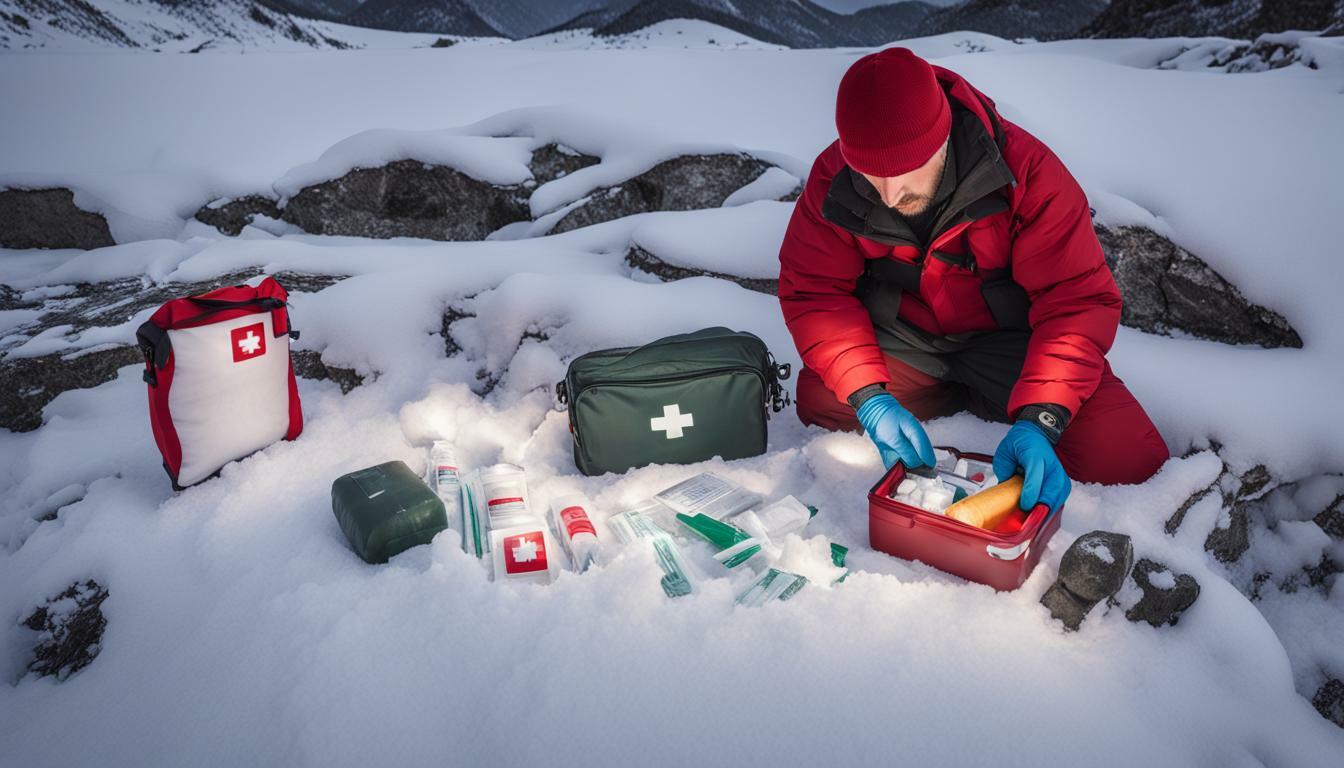
First Aid Kit Training and Certification
While having the right first aid supplies and items in your kit is crucial, knowing how to use them effectively is equally important. In cases of emergency, timing is everything. Adequate training and certification can make all the difference, ensuring you are able to respond quickly and with confidence.
First aid training courses are available through certified organizations across the UK and cover a range of topics, from basic CPR to specific emergency situations. They are typically designed to meet the needs of different groups, including healthcare professionals, workplace first aiders, and the general public.
When selecting a training course, it’s important to consider your specific needs, such as the level of training required and the type of certification provided upon completion. Some training courses may be more suitable for certain environments or scenarios, such as wilderness first aid or paediatric first aid.
Obtaining certification in first aid may also be a requirement for certain professions or activities, such as lifeguards or sports coaches. In addition, some employers may require staff to undergo regular first aid training to ensure compliance with health and safety regulations.
By obtaining the necessary training and certification, you can feel confident in your ability to respond effectively in an emergency situation. It’s a small but crucial step towards being well-prepared and equipped to handle any situation.
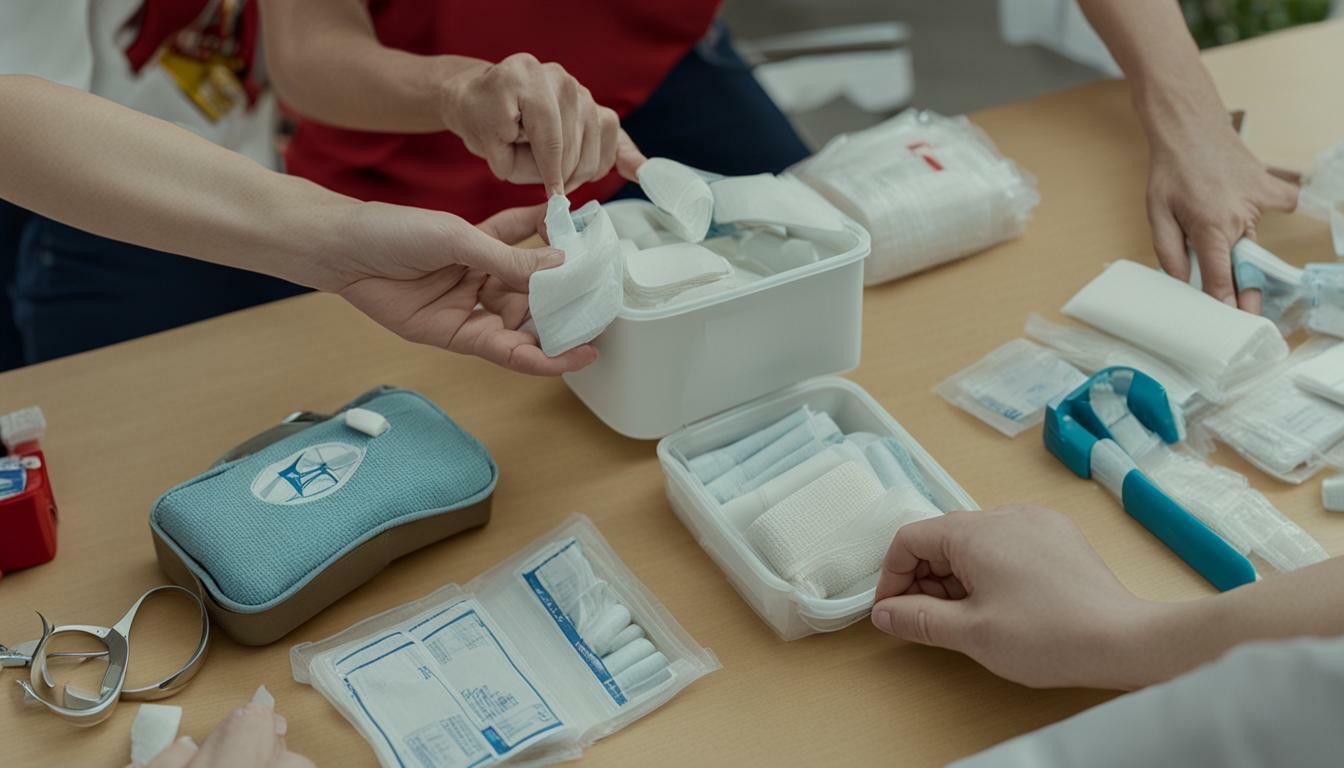
Remember, having a well-stocked and maintained first aid kit is only one part of emergency preparedness. Adequate training and certification can make all the difference when it comes to responding to an emergency effectively, ensuring the best possible outcome for those in need.
Conclusion
Ensuring that your first aid kit is well-maintained and well-stocked is crucial for being prepared in case of an emergency. By regularly checking for expired or missing items, restocking necessary supplies, and organizing your kit, you can help to ensure that you’re ready to respond quickly and effectively when it matters most.
Remember
Check your first aid kit regularly and ensure that it includes all the essentials. Consider any special needs or situations that may arise and tailor your kit accordingly. And don’t forget to obtain the necessary training and certification to use your first aid kit effectively.
By following these guidelines and having a well-stocked and well-maintained first aid kit, you can help to ensure the health and safety of those around you, whether at home or on the go. Stay prepared and stay safe!
